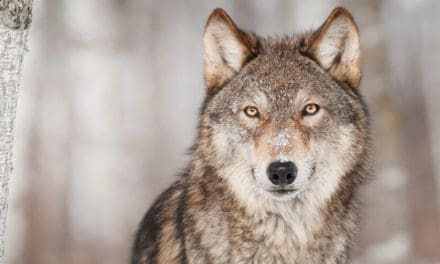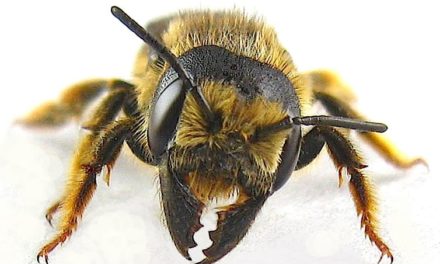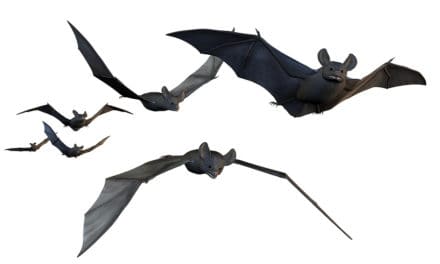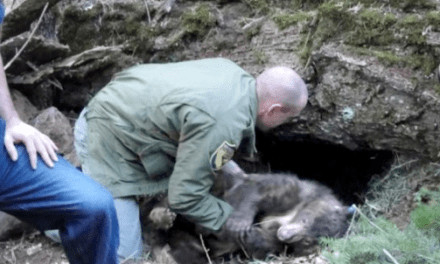The Regal Ring Necked Pheasant
By Melissa Wynn
Although the Ring Necked Pheasant is one of today’s most popular game birds, it is NOT native to North America. Originating in Asia, these farmland foragers are more commonly recognized by Americans than any of the other fifteen groups of pheasants found around the world. In 1881, Judge O.N. Denny released 100 pairs of Chinese ring-necks in the Willamette Valley, south of Portland Oregon, establishing the first successful stronghold of wild pheasants in the United States. The Ring Necked Pheasant of today is actually a hybrid, resulting from cross breeding between the English, Mongolian, Chinese, and Japanese varieties. Perhaps the most successful species ever introduced to this continent, these regally plumed members of the grouse family are now found in every state that offers a suitable habitat.
Like most bird species, the males of this chicken-sized, ground dwelling species is the prettier of the sexes. 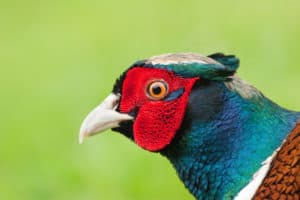 Females are a mottled brown color that allows them to blend in to the brush and shrubbery where they hide for protection. The boys however come dressed for the ball, sporting a brilliantly colored, iridescent, greenish-blue head with bright red patches around the eyes. He proudly wears the bright white-collar that gives him the ring neck nickname. The muscular, rusty colored breast allows the pheasant to take flight quickly in short bursts when threatened and the long tapered tail seems to be simply to impress the ladies.
Females are a mottled brown color that allows them to blend in to the brush and shrubbery where they hide for protection. The boys however come dressed for the ball, sporting a brilliantly colored, iridescent, greenish-blue head with bright red patches around the eyes. He proudly wears the bright white-collar that gives him the ring neck nickname. The muscular, rusty colored breast allows the pheasant to take flight quickly in short bursts when threatened and the long tapered tail seems to be simply to impress the ladies.
Beginning in March these stately studs of the bird world establish territories called crowing grounds, that they viciously defend against other males, and begin to gather their harem. Each male will gather up to 12 hens to call his own throughout the mating season. The girls are picky though and must be wooed into his flock with an impressive display of song and dance. They boys with the best moves get the girls.
In April and May, the hens select a nearby nesting site in an open hay-field, along a fence line or near a secluded brushy area. Each will lay up to fifteen olive-brown eggs, at a rate of one egg per day in a shallow depression that she scratched into the ground and lined with bits of grass or leaves. Twenty-three days later, in early June, they begin to hatch. Ring Necked Pheasant chicks hatch out covered in downy feathers,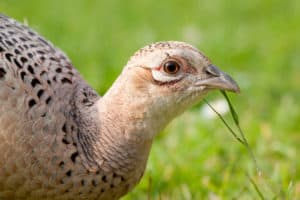 with open eyes, and feed on their own immediately on grains, seeds and insects just like Mom. Dad does not help raise the chicks and by seven weeks they are getting adult feathers and venturing off on their own. These young fledglings all resemble the females at fist. It takes up to eighteen weeks for the males to develop their impressive brightly colored plumage.
with open eyes, and feed on their own immediately on grains, seeds and insects just like Mom. Dad does not help raise the chicks and by seven weeks they are getting adult feathers and venturing off on their own. These young fledglings all resemble the females at fist. It takes up to eighteen weeks for the males to develop their impressive brightly colored plumage.
Pheasants are a bit shy around people so keep your eyes peeled while you are wandering the wilderness this time of year. You might get lucky and spot a good old-fashioned pheasant fight or a brand new clutch of chicks.
Interested in pheasant hunting? Contact your local Department of Fish and Game for permits and dates of the annual fall hunting season.
Facts Courtesy of www.ct.gov


